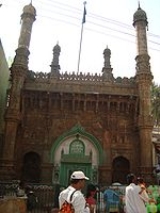
Lakshmeshwar
Encyclopedia
Lakshmeshwara is a town in Shirahatti
taluk, Gadag district
, North Karnataka
, in the India
n state
of Karnataka
. It is about 50 km from Gadag and 55 km from Hubli. Lakshmeshwara is an agricultural
trading
town.
 There are many important temples in this historic town, including the Shiva
There are many important temples in this historic town, including the Shiva
temple, the "Someshwara Temple". There are two historical Jain temples (Sannabasadi and Shankabasadi) in the town, as well as its notable Jamma Masjid. Lakshmeshwara is also home for many shrines, a dargah
, the Kodiyellamma temple, the Mukha Basavanna shrine, and a gigantic idol of Suryanarayana.

 Lakshmeshwara is famous for prolific culture and literature. It is a place with rich heritage in Karnataka
Lakshmeshwara is famous for prolific culture and literature. It is a place with rich heritage in Karnataka
hence it is called as Tirulugannada Nadu. Many kings have patronised the place.
Lakshmeshwar or ancient Huligere or Puligere was the capital of Puligere-300. Puligere means pond of tigers. There are theories of the origin of the name Lakshmeshwara: from King Lakshmanarasa who was ruling Puligere or from the temple called Lakshmi-Lingana gudi, which means the temple of Lakshmi
.
Other names include Purigere, Porigere, Purikanagar and Pulikanagar.
Adikavi Pampa
wrote his famous poetry in Lakshmeshwara.
Many Jain saints and writers have flourished here. They include Devachakra Bhattaraka, Shankanacharya, Hemadevacharya, Padmasena, Tribhuvana Chandra Padmita and Rama Dvacharya.
Sultanate), a dargah and mosque were built. The Kali Masjid here is an ornate structure, built by Bijapur commander Ankush Khan.
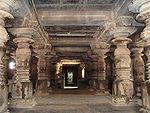
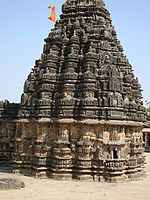
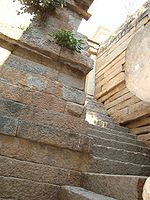
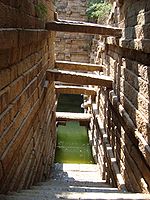 The most important monuments are at Lakshemshwar is the Someshwara temple complex (
The most important monuments are at Lakshemshwar is the Someshwara temple complex (
11th century). The temple complex with three main entrances is surrounded by high walls look like a fort. It is a splendid specimen of Chalukya architecture.
In middle of the temple complex, there is a Someshwara temple, surrounded by many small temples mainly dedicated to Shiva
, along the compound wall, built with granite, some halls in the complex meant for resting devotees.
The Nandi and Shiva
Parvati idols in the temple are exquisitely sculpted. These idols are referred to as Saurashtra Someshwara, as these idols were brought by a Shiva
devotee from Saurashtra and installed at Lakshmeshwara.
This takes back the history of Lakeshmeshwara to 8th century; though the temple is in Chalukya style it has undergone many modifactions and renovations.
Shantinath (Shankha is the symbol of Shantinath), the 16th Jain Thirthankara, is the presiding deity of this Jain Basadi.
Basadi which consists of a Garbhagriha, a large Ardhamandapa, larger Mahamandapa and a Rangamandapa.
The other Jinalaya in this place is a Trikuta dedicated to 'Adinatha.

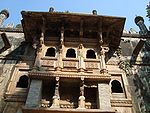
 During Adilshahi rule (Bijapur Sultanate), they built monuments like Masjid, Darga. They adapted the Indo-Saracenic
During Adilshahi rule (Bijapur Sultanate), they built monuments like Masjid, Darga. They adapted the Indo-Saracenic
architectural style. The Jumma Masjid and Ankushkhan Darga are very attractive.
The Jumma Masjid at Lakshmeshwara which dates back to the time of the Adilshahi rule. The mosque was built in 1617 by Ankush Khan.
Jumma Masjid is constructed in Indo-Saracenic
style. The massive doors of the mosque are like a fort entrance. The mosque has two tall minars and a large semicircular dome. There are Dravidian
style chains hanging across the ceiling of the mosque.
architecture style.
s (2080 feet).
, Lakshmeshwar had a population of 33,411. Males constitute 51% of the population and females 49%. Lakshmeshwar has an average literacy rate of 62%, higher than the national average of 59.5%: male literacy is 70%, and female literacy is 53%. In Lakshmeshwar, 13% of the population is under 6 years of age.
Shirahatti
Shirahatti is a panchayat town in Gadag district in the Indian state of Karnataka.-Geography:Shirahatti is located at . It has an average elevation of 659 metres .-Demographics:...
taluk, Gadag district
Gadag District
Gadag District had a population of 971,952 of which 35.21% was urban as of 2001. Population increased 13.14% in the decade 1991-2001. The District is bounded on the north by Bagalkot District, on the east by Koppal District, on the southeast by Bellary District, on the southwest by Haveri...
, North Karnataka
North Karnataka
North Karnataka is an arid plateau from elevation in the Karnataka state of southwest India. It is drained by the Krishna River and its tributaries the Bhima, Ghataprabha, Malaprabha, and Tungabhadra...
, in the India
India
India , officially the Republic of India , is a country in South Asia. It is the seventh-largest country by geographical area, the second-most populous country with over 1.2 billion people, and the most populous democracy in the world...
n state
States and territories of India
India is a federal union of states comprising twenty-eight states and seven union territories. The states and territories are further subdivided into districts and so on.-List of states and territories:...
of Karnataka
Karnataka
Karnataka , the land of the Kannadigas, is a state in South West India. It was created on 1 November 1956, with the passing of the States Reorganisation Act and this day is annually celebrated as Karnataka Rajyotsava...
. It is about 50 km from Gadag and 55 km from Hubli. Lakshmeshwara is an agricultural
Agriculture
Agriculture is the cultivation of animals, plants, fungi and other life forms for food, fiber, and other products used to sustain life. Agriculture was the key implement in the rise of sedentary human civilization, whereby farming of domesticated species created food surpluses that nurtured the...
trading
Trade
Trade is the transfer of ownership of goods and services from one person or entity to another. Trade is sometimes loosely called commerce or financial transaction or barter. A network that allows trade is called a market. The original form of trade was barter, the direct exchange of goods and...
town.

Shiva
Shiva is a major Hindu deity, and is the destroyer god or transformer among the Trimurti, the Hindu Trinity of the primary aspects of the divine. God Shiva is a yogi who has notice of everything that happens in the world and is the main aspect of life. Yet one with great power lives a life of a...
temple, the "Someshwara Temple". There are two historical Jain temples (Sannabasadi and Shankabasadi) in the town, as well as its notable Jamma Masjid. Lakshmeshwara is also home for many shrines, a dargah
Dargah
A Dargah is a Sufi shrine built over the grave of a revered religious figure, often a Sufi saint. Local Muslims visit the shrine known as . Dargahs are often associated with Sufi meeting rooms and hostels, known as khanqah...
, the Kodiyellamma temple, the Mukha Basavanna shrine, and a gigantic idol of Suryanarayana.
History


Karnataka
Karnataka , the land of the Kannadigas, is a state in South West India. It was created on 1 November 1956, with the passing of the States Reorganisation Act and this day is annually celebrated as Karnataka Rajyotsava...
hence it is called as Tirulugannada Nadu. Many kings have patronised the place.
Lakshmeshwar or ancient Huligere or Puligere was the capital of Puligere-300. Puligere means pond of tigers. There are theories of the origin of the name Lakshmeshwara: from King Lakshmanarasa who was ruling Puligere or from the temple called Lakshmi-Lingana gudi, which means the temple of Lakshmi
Lakshmi
Lakshmi or Lakumi is the Hindu goddess of wealth, prosperity , light, wisdom, fortune, fertility, generosity and courage; and the embodiment of beauty, grace and charm. Representations of Lakshmi are also found in Jain monuments...
.
Other names include Purigere, Porigere, Purikanagar and Pulikanagar.
Adikavi Pampa
Adikavi Pampa
Pampa , called by the honorific Ādikavi is one of the greatest Kannada poets of all time.He is very famous even today for his philosophical beliefs...
wrote his famous poetry in Lakshmeshwara.
Many Jain saints and writers have flourished here. They include Devachakra Bhattaraka, Shankanacharya, Hemadevacharya, Padmasena, Tribhuvana Chandra Padmita and Rama Dvacharya.
Kannada inscriptions
At the Someshwara temple complex, there are many Kannada inscription. Over 50 stone inscriptions (records) show the cultural importance.- The Kanarese (Kannadiga) poet Kayasena of MulgundMulgundMulgund is a panchayat town in Gadag district in the Indian state of Karnataka.-Geography:Mulgund is located at . It has an average elevation of 675 metres .-Demographics:...
, who wrote in the Bharmamrita, was a disciple of Narendrasena II of the Lakshmeshwar inscription of 1081. - Lakshmeshwar inscription of the reign of Jagadekamella II.
- Two Jain Inscription of MulgundMulgundMulgund is a panchayat town in Gadag district in the Indian state of Karnataka.-Geography:Mulgund is located at . It has an average elevation of 675 metres .-Demographics:...
and Lakshmeshwar - The Lakshmeshwar inscriptions (in Kannada dated January 13 735), during 733–744 CE Vikramaditya IIVikramaditya IIVikramaditya II was the son of King Vijayaditya and ascended the Badami Chalukya throne following the death of his father. This information comes from the Lakshmeshwar inscriptions in Kannada dated January 13 735...
was the son of King Vijayaditya who ascended the Badami Chalukyas throne following the death of his father.
Jainism
Jainism related to Lakshmeshwara has long history.- At Lakshmeshwara, during the period of Kirtivarma II, the Jinalaya built by Kumkuma Mahadevi.
- Kalyani Chalukyas most important Jinalayas Brahma Jinalaya at LakkundiLakkundiLakkundi in Gadag District of Karnataka is a tiny village on the way to Hampi from Hubli. Lakkundi 11 km from Gadag in the east...
, Charantimatha at AiholeAiholeAihole is a temple complex in the Bagalkot district of Karnataka, India. It is a very popular tourist spot in north Karnataka. It lies to the east of Pattadakal, along the Malaprabha River, while Badami is to the west of both....
and Sankha Jinalya at Lakshmeswar. The Sankha Jinalaya at Lakshmeshwara is dedicated to Neminatha (as per many inscriptions this was an important Jinalaya). Sendraka Durgashakti, a feudatory of Pulakesi IIPulakesi IIPulakesin II is the most famous ruler of the Chalukya dynasty. In his reign the Chalukyas of Badami saw their kingdom extend over most of the Deccan.-Early life and accession:...
is said to have given gifts to this temple. An inscription of Vinayaditya (dated 686 A.D.) refers to a grant to Jain acharya of Devagana and mulasangha. - Epigraph dated 729 A. D. of Vijayaditya mentions a grant to Niravadya Pandita who was to house pupil of Sri Pujyapada. Another inscription of Vikramaditya IIVikramaditya IIVikramaditya II was the son of King Vijayaditya and ascended the Badami Chalukya throne following the death of his father. This information comes from the Lakshmeshwar inscriptions in Kannada dated January 13 735...
(dated 734 A. D.) mentions gifts to Sweta Jinalaya. - The Jaina monument of the RashtrakutaRashtrakutaThe Rashtrakuta Empire was a royal dynasty ruling large parts of the Indian Subcontinent between the sixth and the 10th centuries. During this period they ruled as several closely related, but individual clans. Rastrakutas in inscriptions represented as descendants of Satyaki, a Yadava well known...
period found Lakshmeshwar.
Islamic rulers
During the rule of Adilshahi (BijapurAdil Shahi
The Adil Shahi or Adilshahi dynasty ruled the Sultanate of Bijapur in the Western area of the Deccan region of Southern India from 1490 to 1686. Bijapur had been a province of the Bahmani Sultanate , before its political decline in the last quarter of the 15th century and eventual break-up in 1518...
Sultanate), a dargah and mosque were built. The Kali Masjid here is an ornate structure, built by Bijapur commander Ankush Khan.
Someshwara temple complex




11th century). The temple complex with three main entrances is surrounded by high walls look like a fort. It is a splendid specimen of Chalukya architecture.
In middle of the temple complex, there is a Someshwara temple, surrounded by many small temples mainly dedicated to Shiva
Shiva
Shiva is a major Hindu deity, and is the destroyer god or transformer among the Trimurti, the Hindu Trinity of the primary aspects of the divine. God Shiva is a yogi who has notice of everything that happens in the world and is the main aspect of life. Yet one with great power lives a life of a...
, along the compound wall, built with granite, some halls in the complex meant for resting devotees.
Someshwara temple
Someshwara temple with the traditional structures of a temple includes a garbha griha, an ardha mantapa or halfway hall, a navaranga and a mukha mantapa or entrance porch.The Nandi and Shiva
Shiva
Shiva is a major Hindu deity, and is the destroyer god or transformer among the Trimurti, the Hindu Trinity of the primary aspects of the divine. God Shiva is a yogi who has notice of everything that happens in the world and is the main aspect of life. Yet one with great power lives a life of a...
Parvati idols in the temple are exquisitely sculpted. These idols are referred to as Saurashtra Someshwara, as these idols were brought by a Shiva
Shiva
Shiva is a major Hindu deity, and is the destroyer god or transformer among the Trimurti, the Hindu Trinity of the primary aspects of the divine. God Shiva is a yogi who has notice of everything that happens in the world and is the main aspect of life. Yet one with great power lives a life of a...
devotee from Saurashtra and installed at Lakshmeshwara.
Open well
In side the Someshwara temple complex, behind the temple there is an open well, meant mainly for the use of the temple.Jain Basadis
Lakshmeshwara is one of the ancient Jain centres. Many Jain temples are mentioned in the inscriptions.Shanka Basadi
Of the two historical Jinalayaa at Lakshmeswar the more famous is Sankha Jinalaya, also called Sahasrakuta Jinalaya, is in the BastiBana area.This takes back the history of Lakeshmeshwara to 8th century; though the temple is in Chalukya style it has undergone many modifactions and renovations.
Shantinath (Shankha is the symbol of Shantinath), the 16th Jain Thirthankara, is the presiding deity of this Jain Basadi.
Basadi which consists of a Garbhagriha, a large Ardhamandapa, larger Mahamandapa and a Rangamandapa.
- The rangamandapa has three entrances (south, north and west). It has a chaturmukha structure in dimunitive model, each of which carries three figures. it has a rekhanagara sikhara. The unique feature of this temple is the Sahasrakuta Jinabimba in minute form.
- There is a Manasthamba erected in front of the temple.
- There are ventilated walls in front of the temple. Where as yakshas and yakshis can be found in the other walls. there are many splendid carvings of dancers and musicians.
- Inside the temple one can find the rare monolithic piece of Sahasra Jinabimbas and the idols of Dharnendra and Padmavathi.
- Many mutilated Jain idols can be found on the wall of a well nearby.
- Adikavi PampaAdikavi PampaPampa , called by the honorific Ādikavi is one of the greatest Kannada poets of all time.He is very famous even today for his philosophical beliefs...
wrote Adi Purana, seated in this Basadi. - Basadi is in ruins and renovated, it presents the interest of the Kalyani Chalukyas in Jain architecture.
The other Jinalaya in this place is a Trikuta dedicated to 'Adinatha.
Ananthanatha basadi
Another Jain temple at Lakshmeshwara is the Ananthanatha Basadi, built in AD 1250, which is in the middle of the town. This Basadi is an example of the Chalukya style of architecture. The idol of Ananthanatha, one of the 24 Thirthankars, is installed in the sanctum sanctorum of the shrine.Islamic monuments



Indo-Saracenic
The Indo-Saracenic Revival was an architectural style movement by British architects in the late 19th century in British India...
architectural style. The Jumma Masjid and Ankushkhan Darga are very attractive.
Jumma Masjid
At Lakshmeshwar there is an artistically raised mosque (masjid) in the style of a Hindu temple of Adilshahi times.The Jumma Masjid at Lakshmeshwara which dates back to the time of the Adilshahi rule. The mosque was built in 1617 by Ankush Khan.
Jumma Masjid is constructed in Indo-Saracenic
Indo-Saracenic
The Indo-Saracenic Revival was an architectural style movement by British architects in the late 19th century in British India...
style. The massive doors of the mosque are like a fort entrance. The mosque has two tall minars and a large semicircular dome. There are Dravidian
Dravidian architecture
Dravidian architecture was a style of architecture that emerged thousands of years ago in Southern part of the Indian subcontinent or South India. They consist primarily of pyramid shaped temples called Koils which are dependent on intricate carved stone in order to create a step design consisting...
style chains hanging across the ceiling of the mosque.
Historical Dagha
Ankushkhan Darga might have been named after Ankushkhan of Bijapur. The Dargha is near the KSRTC bus stand of Lakshmeshwar. It is as old as Jumma Masjid. It is constructed in Indo-SaracenicIndo-Saracenic
The Indo-Saracenic Revival was an architectural style movement by British architects in the late 19th century in British India...
architecture style.
Geography
Lakshmeshwar is at 15.13°N 75.47°E. It has an average elevation of 634 metreMetre
The metre , symbol m, is the base unit of length in the International System of Units . Originally intended to be one ten-millionth of the distance from the Earth's equator to the North Pole , its definition has been periodically refined to reflect growing knowledge of metrology...
s (2080 feet).
Demographics
India censusCensus
A census is the procedure of systematically acquiring and recording information about the members of a given population. It is a regularly occurring and official count of a particular population. The term is used mostly in connection with national population and housing censuses; other common...
, Lakshmeshwar had a population of 33,411. Males constitute 51% of the population and females 49%. Lakshmeshwar has an average literacy rate of 62%, higher than the national average of 59.5%: male literacy is 70%, and female literacy is 53%. In Lakshmeshwar, 13% of the population is under 6 years of age.
Also visit
|
Sudi Sudi , is a panchayat town in the Gadag District of Karnataka, India. It is about 30 km from Badami, 12 km from Gajendragad and 3 km from Itagi Bhimambika temple. In the past it was a important town of the Kalyani Chalukyas during 1000 AD... Mahadeva Temple (Itagi) Itagi is in Yalburga Taluk, Koppal District, in North Karnataka, Karnataka, India. It is about 7 km from Kuknur. It is near to Lakkundi about 20 km.Itagi is famous for the Chalukya style Mahadeva Temple... Haveri Haveriis a town in Karnataka. It is the administrative headquarters of Haveri District. The name Haveri is derived from the Kannada words havu and keri, which means place of snakes. Haveri is famous for its cardamom garlands. It is said that Haveri had around 1000 maths in ancient days. One of... North Karnataka North Karnataka is an arid plateau from elevation in the Karnataka state of southwest India. It is drained by the Krishna River and its tributaries the Bhima, Ghataprabha, Malaprabha, and Tungabhadra... |

